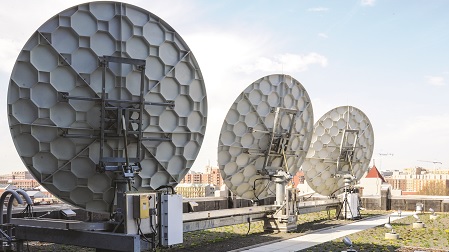Taking a Grounded Approach to Live Content Delivery
Making the switch from satellite to IP can future-proof live content delivery

NEW YORK—The last two decades have seen an enormous proliferation of video content – and sports and other live events have been no exception, as a broader range of content has found its own audiences. Yet, at the same time, the value of each piece of programming has fallen and broadcasters must now find ways to do more with less. The upshot is it is harder for rights holders to justify the inherent cost of the “live-via-satellite” link that has been a mainstay of many live productions for decades.
Internet-based delivery models are now coming to the fore as a compelling alternative to the commercial communications satellite for broadcasters and other rights holders. As a result, satellite’s role in the TV ecosystem is waning, with close to six decades as the bedrock of live video delivery to and from almost anywhere in the world being eroded by IP-centric approaches.
Furthermore, the rise of multiplatform, over-the-top (OTT) streaming as a way of reaching wider, new and niche audiences has also impacted the use of satellite. The rise of streaming giants and specialist platforms has changed the game and forced everyone in the industry, including traditional linear broadcasters, to increase overall distribution capacity using IP-based methods that employ private fiber networks and the public internet to deliver live feeds.
These trends are forcing many sports and news broadcasters to evaluate the role internet-based delivery models will play in the future of their operations. Critical factors most need to look at include the balance between capital expenditure (CAPEX) and operational costs and, increasingly, the potential that IP models offer over satellite for future-proofing their businesses.
The hybrid model
IP is not a one-size-fits-all approach but offers many options for content contribution and distribution – from the public internet and dedicated leased lines to hybrid set-ups that mix and match different transports to balance cost per GB, capacity, latency and availability.
In weighing up the relative strengths and weaknesses of IP, satellite and hybrid solutions, many broadcasters see shifting away from a satellite-driven approach as necessary for the future due to the IP-based model’s lower cost per circuit and flexibility to rapidly scale up and down. Many like the fact IP solutions offer inherent redundancy and the raw bandwidth to support 4K HDR broadcasts. Fiber options that can be used with IP, such as dynamic synchronous transfer mode (DTM), offer their own advantages.
DTM provides a highly scalable transport and switching layer between IP and fiber for next-generation networks and can deliver a direct point-to-point connection for UHD native video – at lower latency and better predictability than the open internet.
Nonetheless, satellite still can play an important role in live content delivery, such as distribution across a wide geographic area with numerous destinations – for which it can be a simpler and more cost-effective route to take. And even then, it can be integrated with IP-based elements for further distribution on the ground.
The evolution of the TV satellite
The geosynchronous satellite traditionally used to carry TV signals requires significant capital investment and has an operational lifespan of about 15 years. Even though the average per Gb cost of satellite bandwidth has dropped significantly over the last decade, this limited operational window places a cap on how low prices can fall.
Satellite can also be more inherently complex for broadcasters than straight IP-based delivery, adding additional steps and costs to the production process. IP-centric workflows using satellite require steps to encode, transmit and then decode content. Plus, booking satellite circuits is a pre-planned process involving a rigid schedule. While buying “always-on” satellite capacity may be an option for larger CNN-type organizations, smaller, more cost-sensitive operations face inherent technical and CAPEX barriers.
However, satellite is evolving, and the next generation of low earth orbit (LEO) satellite constellations are launching at a rapid rate. These offer low latency and use IP transport, making them potentially more efficient for broadcasters with end-to-end IP workflows.
The growing appeal of IP
The shift to IP is built upon the vast amount of fiberoptic cable laid over the last decade, and when paired with 5G technology, the combined infrastructure capacity can exceed the equivalent satellite footprint. In practice, IP can ensure that a video stream – from a football stadium to a production center on the other side of the continent, for instance – will deliver a consistent circuit and low latency for a significantly lower cost than the equivalent satellite feed.
Furthermore, building workflows centered entirely on IP-based video feeds creates new opportunities for broadcasters and streaming services to meet the expectations of multidevice consumers. IP workflows make dynamic content creation much easier to manage while unlocking the potential of remote and cloud-based production to support more flexible and efficient content creation for multiple platforms.
Satellites, on the other hand, are not always reliable. Heavy snow or rain can affect transmitters, causing signal degradation. What’s more, the unpredictable nature of live event coverage can be a factor. For example, a delay in a press conference or game kick-off can mean that the allocated circuit may not be available when needed – so often excess, potentially wasted capacity needs to be booked.
SAT to IP migration in the real world
Regional Sports Networks offer a great example of how shifting to IP-based content distribution from satellite strongly appeals to broadcasters seeking to balance scalability and costs as they look to the future. For instance, New England Sports Network (NESN) worked with The Switch over the last two years to replace its existing satellite distribution network with a next-generation hybrid private fiber and internet distribution model.
NESN’s migration to a terrestrial distribution platform enabled it to build direct private fiber into its affiliates in areas that the broadcaster identified as its most important markets. This roll-out resulted in a significant improvement in signal quality delivered to the affiliates and a corresponding reduction in monthly costs to the client for the distribution network.
Grounded in the future
Satellite-based communication for TV will not vanish overnight. But the shift to IP will accelerate as global telecoms giants push up costs as they purchase more satellite spectrum for 5G, and broadcasters look for the scalability, redundancy and other pluses that IP-based delivery and workflows offer.
With high-profile live events such as the Olympics and the World Cup on the horizon and sports leagues seeking to increase fan engagement, rights holders are looking for ways to spend less but still do more. For many, it makes more sense than ever to shift from satellite to an IP-centric approach, which offers a quick-to-deploy “on-demand” service and billing model.
Robert Szabo-Rowe is the senior vice president of engineering and product management at The Switch
Get the TV Tech Newsletter
The professional video industry's #1 source for news, trends and product and tech information. Sign up below.
Robert Szabo – Rowe is the Head of Engineering and Product Management at Tata Comms Media.

